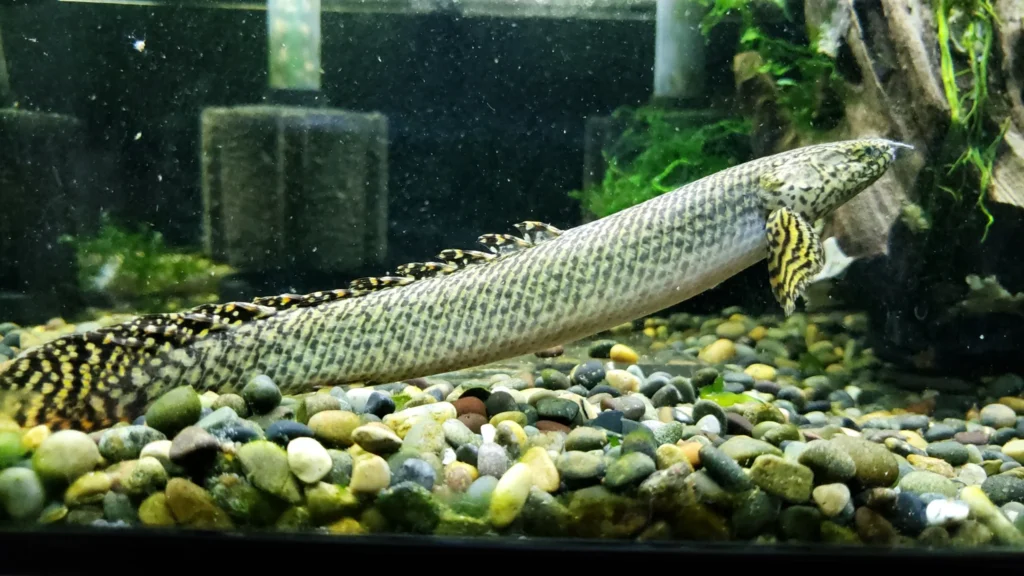
Learn how to care for bichirs with this friendly, detailed guide. Discover ideal tank size, setup tips, tank mates, feeding, behavior, and lifespan to help your prehistoric fish thrive.
Every time I glimpse a bichir in my tank, it’s like stepping into a prehistoric scene. They glide with a dinosaur-like grace, sporting heavy armor scales—a glimpse back in time. But caring for one isn’t just a setup task—it’s a journey into understanding an ancient fish’s needs.
Quick answer: Bichirs are hardy, bottom-dwelling, nocturnal fish that need a large tank, soft substrate, a secure lid, and protein-rich feeding for a healthy life.
Understanding Bichirs
Size & Lifespan
Bichir species vary widely, ranging from about 1 to 2.5 feet long, depending on the type. They usually live 10–15 years in captivity, with potential to reach 20 years under optimal care.
Quick answer: Expect a bichir to grow between 1 and 2.5 feet and live up to 15 years—or longer with great care.
Setting Up the Right Tank
Tank Size
Aim for a minimum 90-gallon tank for most bichirs. Larger species, like ornate or delhezi bichirs, may need 180 gallons or longer tanks (72″ × 24″).
Quick answer: Use at least 90 gallons for most bichirs; larger species need wider, longer tanks.
Substrate, Decor & Lid
Choose soft sand to protect their delicate bellies. Decorate with driftwood, rocks, and shaded spots—they appreciate hiding places. Bichirs are escape artists, so keep a tight-fitting lid with space (≥2″) above the surface for air access.
Quick answer: Provide soft sand, hiding zones, and a secure lid with a small air gap—bichirs need to breathe air and won’t hesitate to explore.
Water Parameters & Filtration
Keep water between 74–82°F, pH 6.2–7.8, and moderate hardness (5–20 dKH). Use gentle filtration, avoiding strong currents—bichirs prefer calm water and sip air at the surface. Monitor equipment daily and test water weekly. Change 10–25% of water every 2–4 weeks.
Quick answer: Maintain warm, soft water with gentle flow, steady filtration, and regular testing for happy bichirs.
Feeding Bichirs
Diet
Bichirs are nocturnal carnivores. Provide a mix of protein-rich foods: bloodworms, shrimp, earthworms, ox heart, and live prey. Pellets can be supplementary but shouldn’t be the staple.
Feed at night or early morning, letting them eat for about 1–2 minutes.
Quick answer: Feed bichirs protein-rich foods at night, using a mix of live, frozen, and prepared options in small portions.
Behavior, Tank Mates & Safety
Behavior
Bichirs are largely peaceful but territorial and nocturnal. They use smell and electric sensing rather than sight to hunt.
Quick answer: Bichirs are calm dead-of-night hunters with strong territorial instincts.
Tank Mates
Choose larger fish that won’t fit in their mouths: Oscars, jack dempseys, large catfish, knifefish, or silver dollars. Avoid small fish—they may become a snack.
Quick answer: Buddy bichirs with big, peaceful tank mates—anything smaller is a risk.
Health & Maintenance
General Care
Look for clear eyes, good appetite, and active behavior as health indicators. Watch for signs of illness—like fin rot, ich, or lethargy—and improve water quality promptly.
Quick answer: Clear eyes, lively feeding, and clean water mean a healthy bichir—address health issues quickly.
Breeding Insights
Breeding bichirs is challenging and varies by species. Senegal bichirs scatter eggs among dense plants; hatchlings need brine shrimp and protection from parents.
Quick answer: Breeding is tricky—Se ngal bichirs scatter eggs among plants and fry need separate care.
Common Questions (FAQ)
-
How big do bichirs get?
They reach 1–2.5 feet, depending on species. -
What tank size do they need?
Minimum 90 gallons; larger species may require 180+ gallon long tanks. -
How long do they live?
Typically 10–15 years; some live up to 20+ years. -
What water conditions do they need?
Temperature 74–82°F, pH 6.2–7.8, moderate hardness 5–20 dKH. -
What do they eat?
Carnivorous diet—bloodworms, shrimp, earthworms, ox heart, plus some pellets. -
Do they require a lid?
Yes, with a small air gap—bichirs breathe surface air and escape easily.
Personal Anecdotes & Tips
When I added a bichir to my tank, I underestimated its love for the surface. At first, I didn’t leave enough gap—they scratched at the lid that first night. Now, I keep a neat 2-inch gap, and they glide up for breaths without risking an escape.
Night feeding became a mini ritual. I use a red moonlight, and their slow stalking at night is mesmerizing—like a prehistoric ballet.
And decor matters: I learned quickly that tight hiding spots help reduce stress during daytime. Driftwood caves are their safe zones.
Conclusion – Your Own Prehistoric Explorer
Caring for a bichir is like hosting a piece of ancient history. They may glide bottom-first, but they bring up awe all night long. With the right tank size, soft substrate, a secure lid, thoughtful tank mates, and consistent maintenance, they can be a stunning, hardy companion for years to come.
If you’re ready to add an ancient explorer to your tank, consider bichirs—they’re a conversation starter and a joy to care for.
